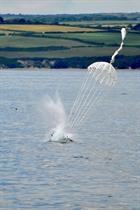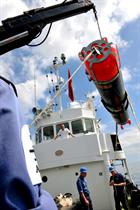Merlin Mk2s test their Stingray torpedoes
From Navy News
The Navy’s newest submarine hunter tested closing in for the kill as Merlin Mk2 helicopters carried out torpedo drops off the Cornish coast.
The launches of the practice torpedoes – identical to the real thing except for the 100lb warhead – are the first held in Falmouth Bay in nearly two decades.
A Merlin Mk2 of the Flying Tigers releases a Sting Ray torpedo into Falmouth Bay as the world’s No.1 submarine hunting helicopter gets back to its core duty which is, er, hunting submarines.
With the new version of the Merlin entering front-line service – after nearly 15 years, the Culdrose-based helicopter has upgraded from the Mk1 to Mk2 – there’s been an escalation in anti-submarine warfare training.
It’s what Merlin was built for – but in its first incarnation, the helicopter has probably spent more time performing other duties (hunting pirates/terrorists, carrying supplies and personnel, search and rescue missions) than going on the hunt for what lurks beneath for the waves.
Earlier this year the new helicopters deployed en masse aboard HMS Illustrious for Deep Blue, the largest anti-submarine exercise
That workout in the Western Approaches was mostly focused on pinging and using sonobuoys to locate and track submarines – as well as test the ability of Merlin fliers to maintain a large-scale round-the-clock hunt for the first time in many years.
The hunt is all well and good. But it’s nothing without the kill.
So the 814 Naval Air Squadron fliers made use of the deep waters of Falmouth Bay to drop the Surface Fleet and Fleet Air Arm’s principal weapon in the war against the submarine: Sting Ray torpedo.
A Merlin can carry up to four Sting Rays – each packed with a 100lb explosive charge (though not in Falmouth Bay, practice torpedoes were dropped) – which race through the water at more than 50mph as they close for the kill.
“Part of the development programme for Merlin Mk 2 is its ability to deliver a fatal blow to any aggressor”, explained Lt Sean Carnew, the Merlin Helicopter Force’s aviation warfare officer.
“The Sting Ray is the standard torpedo used throughout the Fleet Air Arm and is more than capable of making an enemy submarine commander think twice before attacking our ships.”
It is planned to conduct up to 20 torpedo releases a year in the Falmouth Bay area; the Sting Rays are loaded aboard the helicopters at nearby Culdrose and recovered by Serco using boats working out of the Cornish port once their run has ended.
“After an 18-year break in releasing these training torpedoes in Falmouth Bay, we hope to practise Merlin crews more regularly on one of their core skills,” Lt Carnew added.
“We can train efficiently in the local area – which saves the aviation fuel costs associated with transiting time to other parts of the UK.”




